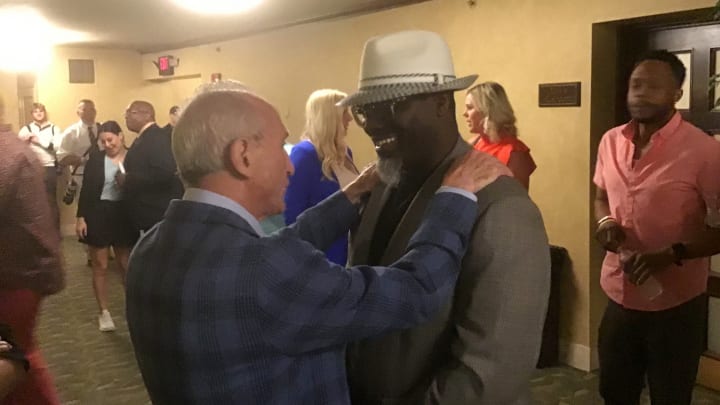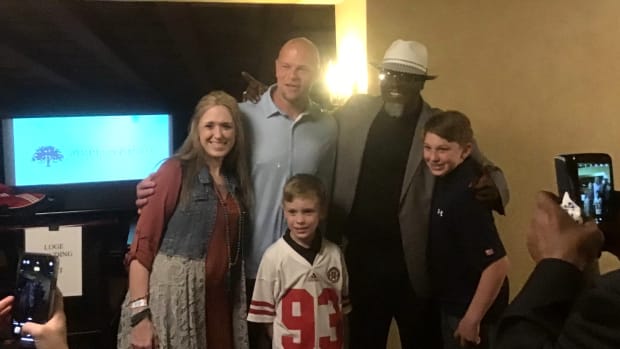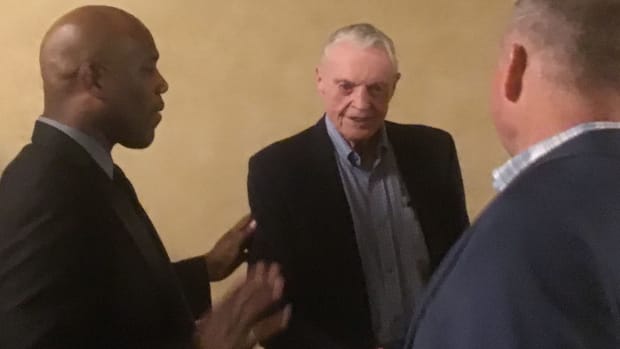Tad Stryker: Smashmouth Flashback

The fading spirit of E Pluribus Unum, to which many generations of Americans once aspired, was very much alive at Lincoln’s Rococo Theatre on May 12, during the premiere of a new documentary about the glory years of Nebraska football under Tom Osborne.
A good representation of players from the 1990s came together to watch the Huskers’ version of the anticipated “30 by 30” film that ESPN never got around to finishing. Produced by nationally known filmmaker Justin LePera and former Huskers Mark Brungardt and Josh Davis, this is actually the first of two episodes, titled “Day By Day: The Rise.”
As Jack Stark and Vershan Jackson demonstrate in the photo at the top of this page, the regathering of 1990s Huskers bridged generational and racial gaps like nobody’s business. They also illustrate two big reasons the Huskers were successful — innovative genius and gritty blue-collar physicality. Stark helped pioneer sports psychology at NU, and Jackson, a running back and linebacker out of Omaha South High School, became a blocking tight end who helped blow open holes for I-backs Ahman Green, Clinton Childs and Damon Benning to ramble through, and still could surprise opponents as a red zone receiving threat.

Husker legends with more than two decades’ worth of additional mileage on them kept walking into the theater. Jared Tomich’s wide-eyed young sons met teammates they had only heard their dad tell them about. Osborne circulated throughout the evening, greeting players, their families and Husker fans who paid a premium to see the film and absorb the atmosphere. Shouts of recognition echoed through the foyer. Handshakes and embraces filled the evening. It took a while for event organizers to persuade everyone to settle in and watch the film, but once they did, everyone’s attention was riveted to the screen.
The documentary cycles through Osborne’s early “can’t win the big one” years after he took over for Husker legend Bob Devaney, but heavily features the 1994 season. Spoiler alert: What you won’t see in this film is a single moment of quarterback Brook Berringer’s best game, the sun-splashed 24-7 win over Colorado in Memorial Stadium, which no doubt is being saved as a flashback scene in the sequel, which will pick up where this film ended, at the 1994 national championship. One thing it does show is the competitive fire which still burns hot in Trev Alberts, the Husker athletic director, who still regrets he couldn’t make just one more big play in the 18-16 loss to Florida State that emotionally fueled the Huskers’ rise to legendary status over the next four seasons.

The producers developed a now-familiar narrative, the stunning discovery of Tommie Frazier’s blood clots, which seemingly dealt another fatal blow to the Huskers’ endless futile quests for a national title, and paid homage to second-string quarterback Berringer, who rose to the occasion despite having to battle his way through the complications of a collapsed lung. Plenty of time and energy is devoted to the angst surrounding the Frazier/Berringer controversy that swirled through Husker Nation as it prepared for the epic Jan. 1, 1995, Orange Bowl matchup with Miami. They brought us a flash of memory as once again, we saw the 57-year-old head coach trotting onto the Orange Bowl turf in his now-iconic red, black and white polo shirt and khakis, and a flood of emotion as we once again heard NBC play-by-play announcer Tom Hammond’s heartfelt tribute to Osborne with his reference in the game’s final seconds to Longfellow’s “A Psalm of Life.”
The influence of the Hall of Fame coach — whose career certainly epitomized the virtues of achieving, pursuing, laboring and waiting — echoed through the words of his players and colleagues and was captured in a few video interviews before and after the screening.

After the film ended, four former Husker players, along with former coach Ron Brown, took the stage for an informal panel discussion hosted by LePera. They fielded questions from fans and were obviously in the mood to take a few good-natured jabs at one another. One fan asked which would be most likely to win a fight. Clinton Childs, Jared Tomich, Matt Hoskinson and Jackson quickly settled on their answer: Brown would win — and they acknowledged he looked younger than any of them.
Brown enjoyed the humorous byplay, but things quickly turned serious when he reminded spectators that one of the Huskers’ strengths was the melting pot approach that prevailed under Osborne, a strategy that promoted unity on the team and long-lasting friendships that are obvious a quarter century later.
Husker fans of a certain age who watch this film will relive some familiar and memorable themes of anticipation, conflict and resolution. Viewers of all ages will encounter a reminder of what the spirit of unity can accomplish.

More
- Video from premiere night
- Wednesday: Tom Osborne interview
- Thursday: Jared Tomich interview
- Friday: Grant Wistrom interview
- More about the film
